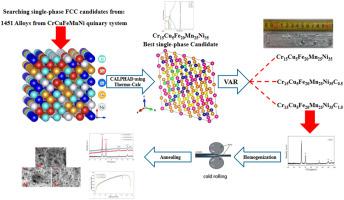The effect of carbon on the microstructures and mechanical properties of non-equiatomic Cr15Cu5Fe20Mn25Ni35 high-entropy alloy
IF 7
2区 材料科学
Q1 MATERIALS SCIENCE, MULTIDISCIPLINARY
引用次数: 0
Abstract
This study investigates the effects of carbon addition on the microstructure and mechanical properties of a single-phase face-centered cubic (FCC) Cr15Cu5Fe20Mn25Ni35 high-entropy alloy (HEA) at room temperature. The alloy was identified as a promising single-phase FCC candidate through systematic thermodynamic calculations using the Calculation of Phase Diagrams (CALPHAD) method and Thermo-Calc software, with validation from X-ray diffraction analysis of the as-cast alloy. The introduction of carbon at concentrations of 0.5 and 1 atomic percent increased the yield strength from 250 MPa to 300 MPa and 350 MPa, respectively, and tensile strength from 500 MPa to 550 MPa and 600 MPa, while enhancing elongation to failure from 20 % to 25 % and 30 %. Microstructural characterization using X-ray diffraction, scanning electron microscopy, and electron backscatter diffraction revealed no alteration in the FCC structure, but a refinement of grain size from 10 μm to 5 μm and a more random crystallographic texture. Additionally, transmission electron microscopy (TEM) analysis demonstrated dense, parallel deformation twins in the alloy with 1 atomic percent of carbon, confirming that twinning significantly contributes to improved ductility and strain hardening. The strengthening effects of carbon are attributed to solid solution strengthening and mechanisms such as twinning. These findings provide valuable insights into tailoring HEA properties through interstitial modifications, contributing to the broader understanding of materials science and the development of high-performance alloys for various applications.

碳对非等原子 Cr15Cu5Fe20Mn25Ni35 高熵合金微观结构和力学性能的影响
本研究探讨了添加碳对室温下单相面心立方(FCC)Cr15Cu5Fe20Mn25Ni35 高熵合金(HEA)的微观结构和机械性能的影响。通过使用相图计算 (CALPHAD) 方法和 Thermo-Calc 软件进行系统的热力学计算,并通过对铸造合金的 X 射线衍射分析进行验证,确定了该合金是一种有前途的单相 FCC 候选材料。引入浓度为 0.5 和 1 原子百分数的碳后,屈服强度分别从 250 兆帕提高到 300 兆帕和 350 兆帕,抗拉强度从 500 兆帕提高到 550 兆帕和 600 兆帕,而失效伸长率则从 20% 提高到 25% 和 30%。利用 X 射线衍射、扫描电子显微镜和电子反向散射衍射进行的微观结构表征显示,催化裂化结构没有发生变化,但晶粒大小从 10 μm 细化到 5 μm,结晶纹理更加随机。此外,透射电子显微镜(TEM)分析表明,在碳含量为 1 原子百分比的合金中存在致密的平行变形孪晶,证实了孪晶对改善延展性和应变硬化有显著作用。碳的强化作用归因于固溶强化和孪晶等机制。这些发现为通过间隙改性定制 HEA 性能提供了宝贵的见解,有助于更广泛地了解材料科学和开发各种应用的高性能合金。
本文章由计算机程序翻译,如有差异,请以英文原文为准。
求助全文
约1分钟内获得全文
求助全文
来源期刊

Materials Science and Engineering: A
工程技术-材料科学:综合
CiteScore
11.50
自引率
15.60%
发文量
1811
审稿时长
31 days
期刊介绍:
Materials Science and Engineering A provides an international medium for the publication of theoretical and experimental studies related to the load-bearing capacity of materials as influenced by their basic properties, processing history, microstructure and operating environment. Appropriate submissions to Materials Science and Engineering A should include scientific and/or engineering factors which affect the microstructure - strength relationships of materials and report the changes to mechanical behavior.
 求助内容:
求助内容: 应助结果提醒方式:
应助结果提醒方式:


